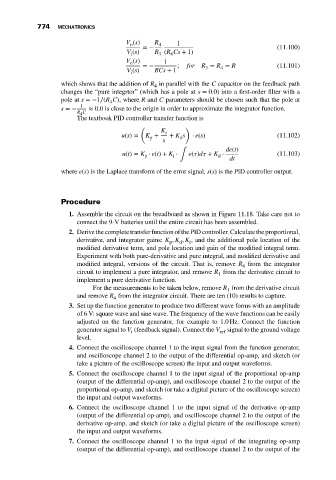Page 788 - Mechatronics with Experiments
P. 788
774 MECHATRONICS
V (s) R
o 4 1
=− (11.100)
V (s) R (R Cs + 1)
4
3
i
V (s) =− 1 ; for R = R = R
o
V (s) RCs + 1 3 4 (11.101)
i
which shows that the addition of R in parallel with the C capacitor on the feedback path
4
changes the “pure integrtor” (which has a pole at s = 0.0) into a first-order filter with a
pole at s =−1∕(R C), where R and C parameters should be chosen such that the pole at
4
1
s =− ≈ 0.0 is close to the origin in order to approximate the integrator function.
R 4 C
The textbook PID controller transfer function is
( )
K i
u(s) = K + + K s ⋅ e(s) (11.102)
p d
s
de(t)
u(t) = K ⋅ e(t) + K ⋅ ∫ e( )d + K ⋅ dt (11.103)
i
p
d
where e(s) is the Laplace transform of the error signal, s(s) is the PID controller output.
Procedure
1. Assemble the circuit on the breadboard as shown in Figure 11.18. Take care not to
connect the 9-V batteries until the entire circuit has been assembled.
2. Derive the complete transfer function of the PID controller. Calculate the proportional,
derivative, and integrator gains: K , K , K , and the additional pole location of the
p
d
i
modified derivative term, and pole location and gain of the modified integral term.
Experiment with both pure-derivative and pure integral, and modified derivative and
modified integral, versions of the circuit. That is, remove R from the integrator
4
circuit to implement a pure integrator, and remove R from the derivative circuit to
1
implement a pure derivative function.
For the measurements to be taken below, remove R from the derivative circuit
1
and remove R from the integrator circuit. There are ten (10) results to capture.
4
3. Set up the function generator to produce two different wave forms with an amplitude
of 6 V: square wave and sine wave. The frequency of the wave functions can be easily
adjusted on the function generator, for example to 1.0 Hz. Connect the function
generator signal to V (feedback signal). Connect the V ref signal to the ground voltage
i
level.
4. Connect the oscilloscope channel 1 to the input signal from the function generator,
and oscilloscope channel 2 to the output of the differential op-amp, and sketch (or
take a picture of the oscilloscope screen) the input and output waveforms.
5. Connect the oscilloscope channel 1 to the input signal of the proportional op-amp
(output of the differential op-amp), and oscilloscope channel 2 to the output of the
proportional op-amp, and sketch (or take a digital picture of the oscilloscope screen)
the input and output waveforms.
6. Connect the oscilloscope channel 1 to the input signal of the derivative op-amp
(output of the differential op-amp), and oscilloscope channel 2 to the output of the
derivative op-amp, and sketch (or take a digital picture of the oscilloscope screen)
the input and output waveforms.
7. Connect the oscilloscope channel 1 to the input signal of the integrating op-amp
(output of the differential op-amp), and oscilloscope channel 2 to the output of the

